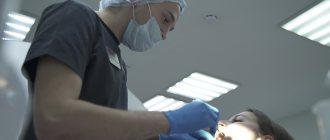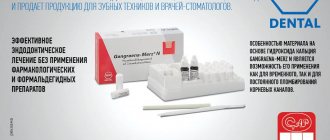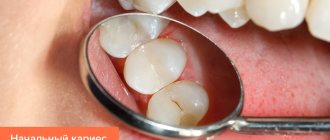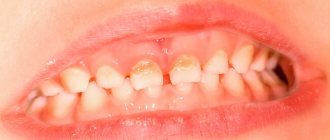Correcting occlusion abnormalities is a long process. It takes months and sometimes years, during which the patient may experience a variety of dental diseases. Braces themselves increase the likelihood of developing tooth decay. All this has led to the fact that at each stage of orthodontic treatment, a whole range of measures is used to prevent and eliminate oral problems. Particular attention is paid to preparation.
Before a patient has a fixed orthodontic design installed, a complete sanitation of the oral cavity is carried out. This procedure includes:
- identification of carious cavities, their cleaning and filling;
- removal of decayed teeth that cannot be treated or restored;
- removal of dental deposits (plaque and tartar);
- elimination of inflammatory processes in the soft tissues of the oral cavity.
The preparatory stage can take quite a long time and require several visits to the clinic. However, such financial and time costs are justified: in this way the patient will save himself from a large number of problems that could otherwise arise during orthodontic bite correction.
Dental treatment and braces
While wearing a fixed orthodontic structure, you can:
- treat caries and pulpitis;
- change and install seals;
- depulpate the tooth, clean the root canals;
- perform surgical operations in the oral cavity, if during medical manipulations the roots of the teeth and the surrounding bone tissue are not affected;
- remove dental plaque with an ultrasonic scaler, polish enamel as part of professional oral hygiene procedures;
- install crowns on teeth if the root of the tooth is not affected.
Crowns before and during orthodontic treatment are installed temporary, since after the teeth are moved, the previously installed crown may require replacement.
How caries develops with braces
Carious lesions rarely develop with braces. Many people mistakenly believe that food debris accumulates under the structure, bacteria multiply and the enamel gradually deteriorates. However, this is just one of the common myths about braces.
In fact, locks that cover part of the tooth surface, on the contrary, protect the enamel from external factors, rather than worsen its condition. Moreover, the glue used to fix the structure on the teeth contains fluoride and calcium, which act as a protective layer that helps restore the enamel.
If caries occurs after installing a brace system, it is a consequence of insufficient oral hygiene or poor nutrition. That is, for the same reasons as people without braces. It’s just that orthodontic structures that complicate hygiene slightly increase the likelihood of caries and other dental diseases. If the patient engages in their prevention, then there should be no complications.
We will talk about the prevention of carious lesions during orthodontic treatment later. First, let’s find out whether it is possible to treat teeth with braces? How is this treatment carried out?
What is not allowed during orthodontic treatment?
A number of dental procedures can disrupt the course of orthodontic treatment, and sometimes make it simply impossible. Such procedures include:
- Dental prosthetics with installation of titanium implants. Metal implants fuse with the bone and, unlike tooth roots, do not move into the bone under the pressure of the braces system.
- Installation of pins. Restoring the tooth root using a pin increases the reliability of fixation of the artificial crown, but contributes to improper distribution of the load on the root during orthodontic correction. This can lead to damage or complete destruction of the tooth root.
- Tooth extraction. Before the correction begins, this manipulation will not cause problems. It’s another matter if the tooth has decayed and requires removal while wearing braces or aligners. This may disrupt your treatment plan.
Fixed orthodontic construction, consisting of a large number of metal elements, can complicate X-ray examination.
Put braces on implants: the situation is not hopeless
- Promotion
SGS implant + crownPromotion for turnkey dental implantation
SGS implant + healing abutment + abutment + crown + work
old price
57 300 ₽
turnkey price, with 100% payment
24 900 ₽
Book an implant
The offer is limited, book the implants on offer in advance. Sign up for a free consultation. Your reservation is valid only after making an advance payment under the Agreement, no later than 10 days from the date of the initial consultation.
- Promotion
Osstem implant + zirconium crown
Promotion for turnkey dental implantation
Osstem implant + healing abutment + abutment + zirconium crown + work
old price
68 400 ₽
turnkey price, with 100% payment
29 900 ₽
Book an implant
The offer is limited, book the implants on offer in advance. Sign up for a free consultation. Your reservation is valid only after making an advance payment under the Agreement, no later than 10 days from the date of the initial consultation.
- Promotion
Astra Tech implant + zirconium crown
Promotion for turnkey dental implantation
Astra Tech implant + gum former + abutment + zirconium crown + work
old price
88 400 ₽
turnkey price, with 100% payment
59 900 ₽
Book an implant
The offer is limited, book the implants on offer in advance. Sign up for a free consultation. Your reservation is valid only after making an advance payment under the Agreement, no later than 10 days from the date of the initial consultation.
- Promotion
Nobel implant + zirconium crown
Promotion for turnkey dental implantation
Nobel implant + healing abutment + abutment + zirconium crown + work
old price
88 400 ₽
turnkey price, with 100% payment
59 900 ₽
Book an implant
The offer is limited, book the implants on offer in advance. Sign up for a free consultation. Your reservation is valid only after making an advance payment under the Agreement, no later than 10 days from the date of the initial consultation.
- Promotion
Straumann implant + zirconium crown
Promotion for turnkey dental implantation
Implant Straumann Roxolid SLActive (
No. 1 in the World! ) + gum former + abutment + zirconium crown + work
old price98 400 ₽
price turnkey price, with 100% payment
59 900 ₽
Book an implant
The offer is limited, book the implants on offer in advance. Sign up for a free consultation. Your reservation is valid only after making an advance payment under the Agreement, no later than 10 days from the date of the initial consultation.
In this case, only a highly qualified orthodontist can make the right decision. The alignment of “living” teeth in the correct row occurs due to the tension of the bracket system created by the orthodontic arch. When implanting an artificial root into the bone and installing a crown on it, dentists tried to organically fit the structure into the existing dentition with an abnormal bite and gave it a corresponding abnormal position. Therefore, the traction of the arc can simply pull the implant out of the bone. But even in this case, bite correction, under certain circumstances and with reservations, can be performed.
Quick appointment Free consultation
Basic approaches to treatment in the presence of orthodontic structures
Caries
Aligners and other removable systems allow you to carry out any dental treatment without restrictions. The structure is removed from the mouth and then put back on. With braces everything is more complicated. Treatment of caries and replacement of fillings do not require removal of the system, except in cases where the design makes it difficult to access the affected area. It will be necessary to remove the power arch and peel off one or more locks in cases where the carious cavity is located in the interdental space, there is a tumor that must be removed immediately, and in some other cases.
Locks that had to be peeled off may require replacement with new ones. When detaching braces from the enamel, a special tool can deform them and make them unsuitable for further use.
With any dental problem, you must first contact your orthodontist, since he is the one who plans and controls the treatment process. And the orthodontist, in turn, will refer you to a specialist of the required profile for treatment.
Professional teeth cleaning
The procedure of professional oral hygiene is not only possible, but also must be carried out during orthodontic correction every 3-6 months. Fixed structures are not an obstacle to this. And cleansing the enamel and individual elements of the system from food debris and bacterial plaque reduces the likelihood of developing caries and inflammatory processes in the gums. Periodic professional cleaning greatly facilitates daily oral care and eliminates unpleasant odor, the source of which is dental plaque accumulated in the system.
The only limitation of the method in the presence of a non-removable structure is the use of Air Flow technology. The flow of water carrying a mixture of air microbubbles and abrasive particles reduces the reliability of the locks, which increases the likelihood of system failure.
When is it better to treat caries with braces?
One of the most difficult types of caries is interdental. It develops between the teeth and lasts for a long time in a hidden form. It can only be detected during an X-ray or laser examination. However, the complexity of the pathology lies not in diagnosis, but in treatment.
Interdental hidden caries forces the doctor to prepare not only the diseased tooth, but also the healthy tooth, since the specialist needs to gain access to the carious cavity and make room for a filling.
If hidden caries develops due to crowded teeth, treatment may be delayed until the defect is corrected. First, the orthodontist will install braces, and after a while, when the teeth change their position a little, he will cure caries. Thus, an orthodontic design can simplify the procedure if a patient is diagnosed with interdental caries due to crowded teeth.
Prevention
In order to maintain dental health while wearing orthodontic appliances, the patient will have to constantly make efforts. To prevent dental problems, a whole range of measures has been developed, which includes recommendations on nutrition, hygienic care, and changing behavioral habits.
Nutrition
The selection of products is carried out in such a way as to solve two problems at once:
- make it easier for a person to get used to wearing the structure;
- reduce the amount of food debris retained by the structure and facilitate cleansing of the oral cavity.
Chewing hard foods can damage the archwire and cause the clasps to come loose. Immediately after installing the structure, nuts, chips, and hard raw vegetables will increase discomfort and pain, which is caused by system pressure that is unusual for a person. All sticky products, such as chewing candies and gum, and processed cheese, are also prohibited. They stick to braces and dental wires and require a significant amount of time to brush your teeth. Ceramic and sapphire clasps and rubber ligatures can change color due to pigments from food and drinks. This is also worth remembering when standing in front of an open refrigerator.
Hygienic care
Out of habit, regularly cleaning your mouth takes a lot of time. Dentists insist that teeth and structures must be cleaned especially thoroughly in the morning and evening. You will also have to brush after every meal during the day. Agree, it's tiring. A good way to wean yourself off snacking.
The aligners are removed during meals. Then the teeth need to be cleaned and the mouth guard put in place. The mouth guard itself can be rinsed in warm water. In case of significant contamination, it can be cleaned with a toothbrush and toothpaste. In this case, the paste must be used without abrasive particles in the composition so that the surface of the aligners is not scratched and does not lose its characteristic wet shine and transparency.
The difficulty of daily cleaning when wearing braces is that food debris must be removed from hard-to-reach places: interdental spaces, places where clasps are attached to the enamel, spaces between the surface of the teeth and the power arch. If you limit yourself to just a toothbrush, you can very quickly develop bleeding gums, inflammation of the soft tissues of the oral cavity, and caries.
To clean fixed orthodontic structures, you will need to use:
- Special toothbrush. For braces, a brush with soft bristles is used, which does not disturb the adhesion of the clasps to the enamel. The small head of the brush allows you to reach the very end of the tooth row.
- Special paste for orthodontic structures. The composition of this paste allows you to more effectively clean metal structural elements and at the same time strengthen the enamel of living teeth.
- Floss (dental floss). Special threads are produced for braces, but regular threads can also be used. They are used to clean interdental spaces.
- Small brushes (brushes). They are necessary in order to remove plaque and food debris in the spaces between the teeth and the arch, and carefully walk along the boundaries of the lock and enamel.
- Irrigator. This is a device for home use, which, in addition to thorough cleansing, provides a gentle massage of the gums, improves blood circulation in the tissues of the oral cavity and solves a number of other problems facing the orthodontic patient.
How to maintain the condition of dentures
Artificial crowns require special care. In this case, you will have to take into account both them and those related to braces. In order not to damage the structure and prosthesis while correcting the bite with your own hands, it is important to know some points.
To maintain the condition of the crowns, the following points should be taken into account:
- plastic elements can absorb food coloring, which will affect the appearance;
- solid foods can damage them, so you should avoid crackers, nuts, and tough meat;
- viscous sweets can also damage both the orthodontic structure and the elements of the prosthesis, and also lead to loss of fillings;
- High temperature foods can cause deformation of braces and pain in teeth under crowns.
Before starting treatment, the dentist will determine individually whether it is possible to install braces on extended teeth, dentures and fillings based on the condition of a particular structure. The general hygiene index of the oral cavity is also taken into account. You may need to undergo extensive training before installation.
More information about the irrigator
An irrigator is a small device that consists of a container of water and a nozzle that delivers a thin, elastic, directed stream of liquid. With this jet you can clean your teeth and interdental spaces, and gently massage your gums. Unlike brushes and brushes, the jet penetrates into the most difficult to reach places and provides better removal of bacterial plaque. The consequence of this is the preservation of the original appearance of the structure and tooth enamel, and the absence of an unpleasant odor.
Wisdom teeth before installing braces: remove or leave?
The answer to this question will be given by the orthodontist after assessing the degree of development of the pathology and the characteristics of the dental system of a particular patient. Unerupted or incompletely erupted “figure eights” lying in the jaw bone horizontally or at an angle must be removed. They disrupt the functionality of neighboring teeth and the supporting apparatus. Extraction may also be recommended if there is insufficient space in the jawbone to move the teeth under the influence of the orthodontic arch in the right direction.
Professional teeth cleaning
When installing braces, it is necessary to take into account the need to have your teeth cleaned by the dentist every few months. Even the most thorough hygienic care cannot ensure the absence of dental plaque if there are braces in the oral cavity. Accordingly, it is imperative to plan the costs of this procedure. Deposits and food debris from teeth and fixed structures are removed using ultrasound. Then the enamel is polished and deeply fluoridated.
As you can see, the prevention and treatment of dental diseases during orthodontic correction is a problem that requires attention from both the orthodontist and his patient. With joint efforts, you can get a perfect smile without caries, fillings and gum damage.
Duration of treatment
The final decision on the need for treatment should be made by a professional dentist and only on the basis of a complete preliminary examination. A specialist can talk about all types of designs, installation methods and duration of treatment in each specific case. However, even the doctor cannot give the exact timing, because much depends on the individual characteristics of the patient’s body.
As a result of the examination, the doctor names the estimated time frame, discusses the cost of treatment and warns about the need to wear special retainers after the braces are removed. Dental correction is a long-term collaboration between the patient and the orthodontist. While wearing the system, it may be necessary to correct, weaken or, conversely, increase the arc pressure, etc.
The exact period of treatment depends on many factors: the specific age of the person, the severity of existing problems, the type of braces installed, as well as the material from which they are made. For mild pathologies, the duration will be about a year, in complex cases – about two years.
previous post
Is it possible to go to the bathhouse after tooth extraction?
next entry











